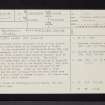Glasgow, Rutherglen Castle
Castle (Medieval)
Site Name Glasgow, Rutherglen Castle
Classification Castle (Medieval)
Canmore ID 45073
Site Number NS66SW 19
NGR NS 6145 6177
Datum OSGB36 - NGR
Permalink http://canmore.org.uk/site/45073
- Council South Lanarkshire
- Parish Rutherglen (South Lanarkshire)
- Former Region Strathclyde
- Former District City Of Glasgow
- Former County Lanarkshire
NS66SW 19 6145 6177.
(NS 6145 6177) Castle (NR) (site of)
OS 6" map, (1968)
Rutherglen Castle occupied a site in King Street, nearly at a point where it is intersected by Castle Street. It was garrisoned by the English during the wars of independence, and is said to have been besieged by Robert the Bruce several times without success, till it was captured by Edward Bruce in 1313. The castle remained in good order till after the battle of Langside (1568) when it was burnt by the Regent Murray. The great tower was later repaired and became the seat of the Hamiltons of Ellistoun. Early in the 18th century, this portion and the new buildings that had been added were abandoned and allowed to become ruinous. Its stones were removed and no trace remains.
D Ure 1793; New Statistical Account (NSA) 1845; F H Groome 1901.
No traces of Rutherglen Castle remain, its site being built upon.
Visited by OS (J L D) 31 March 1954.
Publication Account (1978)
The castle at Rutherglen was granted to Queen Joanna as part of her dowry in 1221 (CDS, i, 808). It was garrisoned by the English during the Wars of Independence and was kept in good repair until after the battle of Langside in 1568, when it was burnt on the orders of the Regent Moray. One of the principal towers was refurbished and it became the seat of the Hamiltons of Elistoun. The castle and gardens were described as being in a state of disorder in 1710 (Wilson, 1936, 10). Ure explained that on the decline of the Hamilton family at the end of the seventeenth century, the 'house was left to fall to ruins by frequent dilapidations, and was soon levelled with the ground' (1793, 28). Foundation stones measuring five feet (1. 5m) in length by four feet (1. 2m) in breadth were removed in 1759. Subsequently, they were built into a dyke adjoining the burgh but by the middle of the last century all trace of them had disappeared (Macdonald, 1854, 90). The castle occupied a site in King Street, nearly at the point where it is intersected by Castle Street in a square measuring from the Salvation Army Hall to Castle Street northward to the south side of the railway embankment, while the grounds 'abutted on the Kirkyard, the Main Street, Rutherglen Green and included the whole of Alleybank' (Shearer, 1922, 73). No vestiges of Rutherglen castle are to be observed above ground level.
Information from ‘Historic Rutherglen: The Archaeological Implications of Development’ (1978).








